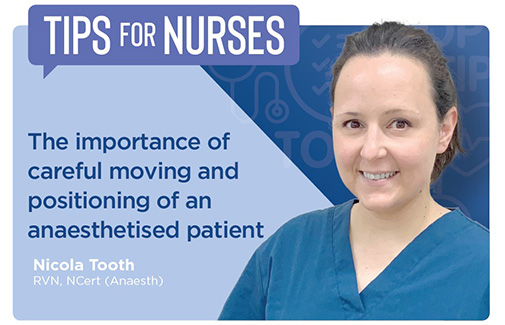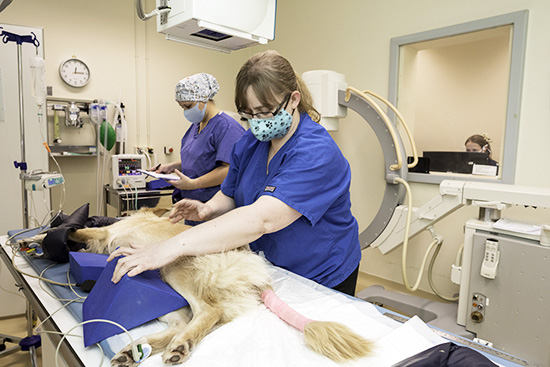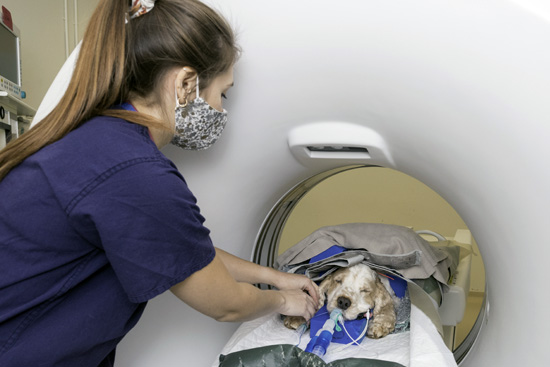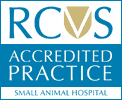The importance of careful moving and positioning of an anaesthetised patient
 Nicola Tooth
Nicola Tooth
RVN, NCert (Anaesth)
When an animal is anaesthetised they will lose all conscious control. It is therefore important to take care when moving a patient from one table to another or when repositioning them. If it is likely that a patient will have multiple table changes during anaesthesia, then the following should be considered:
Moving
- Patients that are moved multiple times during anaesthesia have an increased risk of regurgitation and possible subsequent aspiration pneumonia. This is common in procedures such as orthopaedics, where it is necessary to move the patient from room to room and then repositioning for various radiographic views. To help reduce the risk of regurgitation, turn the animal ‘legs-under’, rather than rolling into dorsal recumbency.
- Use a transfer trolley to transport the animal from room to room, carrying the patient in your arms may result in the head hanging, this could injure the neck or cause airway obstruction.
- Large or heavy breeds should have multiple people to move, this will reduce the risk of accidentally dropping the patient or the head hanging. It will also reduce risk of injury to the handlers.
- Be sure to turn off the oxygen flow to prevent environmental contamination of anaesthetic vapours.
Positioning
-
Supporting the animals head during induction to maintain an open airway and to prevent potential airway obstruction due to collapse of pharyngeal tissues.
- In animals with a high risk of regurgitation pressure can be applied to the cricoid cartilage to occlude the oesophagus during intubation, this prevents potential regurgitation material entering the trachea.
- Prevention of decubitus ulcers beginning to form on bony prominence’s, in particular the slim breeds such as whippet and lurchers.
- Placing a Vetbed under the animal will aid comfort.
- In animals who may already have joint disease consideration whether flexion or extension of the limbs may exacerbate pre-existing joint pain.
- Care should be taken when using limb restraints such as ropes as if too tight blood circulation may be compromised.
- Compartment syndrome may occur if a limb has been allowed to hang over the edge of a table for prolonged periods of time without padding. Foam wedges can be used to provide comfort to such areas. Overextension or hyper flexion of the neck and limbs should be avoided or permanent neurological injury may result.
 Ensure that any heat sources used to maintain body temperature are not too hot. This is especially important around bony prominences which lay heavy on a particular spot. As the animal is unable to move away from the heat, prolonged exposure to this may lead to dermal burns.
Ensure that any heat sources used to maintain body temperature are not too hot. This is especially important around bony prominences which lay heavy on a particular spot. As the animal is unable to move away from the heat, prolonged exposure to this may lead to dermal burns.- Temporarily disconnecting the anaesthetic circuit from the endotracheal tube (ETT) when re-positioning. This will prevent potential tracheal damage from an ETT being twisted or pulled. The anaesthetic tubing should also be supported such that there is no drag on the ETT.
- If turning an animal from one lateral recumbency to the other, time must be allowed in sternal recumbency to allow any atelectasis of the underlying lung to return to normal perfusing lung tissue.
- Caution should be taken for anal/perineal surgeries where the veterinary surgeon may request the patient to be tilted at an angle (Trendelenberg position), to provide access to the surgical area. Remember that this may put pressure on the diaphragm from the abdominal contents pushing down from the force of gravity, monitor for hypoventilation and dyspnoea.




